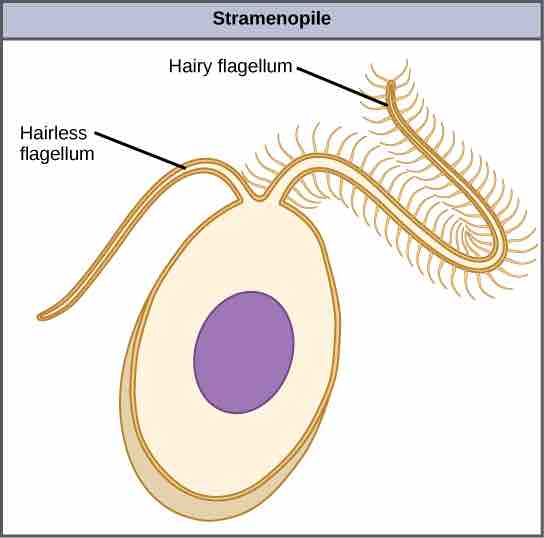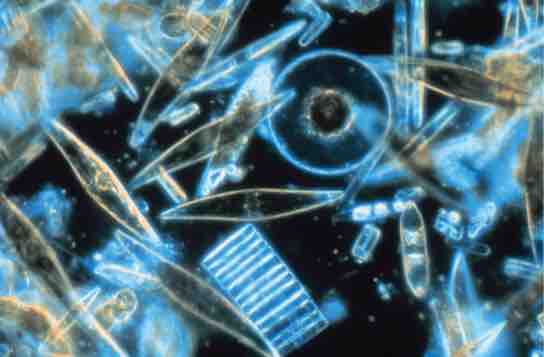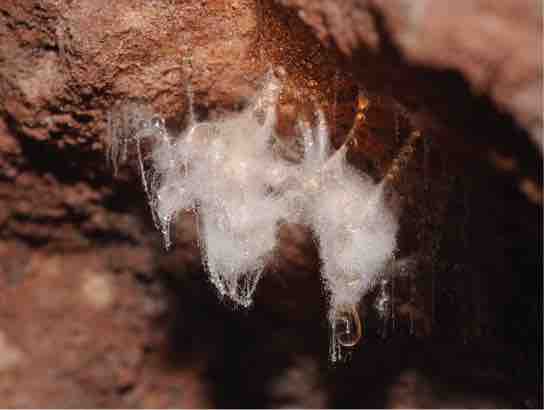Chromalveolates
Current evidence suggests that chromalveolates have an ancestor which resulted from a secondary endosymbiotic event. The species which fall under the classification of chromalveolates have evolved from a common ancestor that engulfed a photosynthetic red algal cell. This red algal cell had previously evolved chloroplasts from an endosymbiotic relationship with a photosynthetic prokaryote. Chromalveolates include very important photosynthetic organisms, such as diatoms, brown algae, and significant disease agents in animals and plants. The chromalveolates can be subdivided into alveolates and stramenopiles.
Stramenopiles
A subgroup of chromalveolates, the stramenopiles, also referred to as heterokonts, includes photosynthetic marine algae and heterotrophic protists. The unifying feature of this group is the presence of a textured, or "hairy," flagellum. Many stramenopiles also have an additional flagellum that lacks hair-like projections . Members of this subgroup range in size from single-celled diatoms to the massive and multicellular kelp.

Stramenophile structure
This stramenopile cell has a single hairy flagellum and a secondary smooth flagellum.
Diatoms
The diatoms are unicellular photosynthetic protists that encase themselves in intricately patterned, glassy cell walls composed of silicon dioxide in a matrix of organic particles . These protists are a component of freshwater and marine plankton. Most species of diatoms reproduce asexually, although some instances of sexual reproduction and sporulation also exist. Some diatoms exhibit a slit in their silica shell called a raphe. By expelling a stream of mucopolysaccharides from the raphe, the diatom can attach to surfaces or propel itself in one direction.

Diatoms
Assorted diatoms, visualized here using light microscopy, live among annual sea ice in McMurdo Sound, Antarctica. Diatoms range in size from 2 to 200 µm.
During periods of nutrient availability, diatom populations bloom to numbers greater than can be consumed by aquatic organisms. The excess diatoms die and sink to the sea floor where they are not easily reached by saprobes that feed on dead organisms. As a result, the carbon dioxide that the diatoms had consumed and incorporated into their cells during photosynthesis is not returned to the atmosphere. In general, this process by which carbon is transported deep into the ocean is described as the biological carbon pump because carbon is "pumped" to the ocean depths where it is inaccessible to the atmosphere as carbon dioxide. The biological carbon pump is a crucial component of the carbon cycle that helps to maintain lower atmospheric carbon dioxide levels.
Golden Algae
Like diatoms, golden algae are largely unicellular, although some species can form large colonies. Their characteristic gold color results from their extensive use of carotenoids, a group of photosynthetic pigments that are generally yellow or orange in color. Golden algae are found in both freshwater and marine environments, where they form a major part of the plankton community.
Brown Algae
The brown algae are primarily marine, multicellular organisms that are known colloquially as seaweeds. Giant kelps are a type of brown algae. Some brown algae have evolved specialized tissues that resemble terrestrial plants, with root-like holdfasts, stem-like stipes, and leaf-like blades that are capable of photosynthesis. The stipes of giant kelps are enormous, extending in some cases for 60 meters. A variety of algal life cycles exists, but the most complex is alternation of generations in which both haploid and diploid stages involve multicellularity. For instance, compare this life cycle to that of humans. In humans, haploid gametes produced by meiosis (sperm and egg) combine in fertilization to generate a diploid zygote that undergoes many rounds of mitosis to produce a multicellular embryo and then a fetus. However, the individual sperm and egg themselves never become multicellular beings. In the brown algae genus Laminaria, haploid spores develop into multicellular gametophytes, which produce haploid gametes that combine to produce diploid organisms that then become multicellular organisms with a different structure from the haploid form . Terrestrial plants also have evolved alternation of generations.

Brown algae life cycle
Several species of brown algae, such as the Laminaria shown here, have evolved life cycles in which both the haploid (gametophyte) and diploid (sporophyte) forms are multicellular. The gametophyte is different in structure from the sporophyte.
Oomycetes
The water molds, oomycetes ("egg fungus"), were so-named based on their fungus-like morphology, but molecular data have shown that the water molds are not closely related to fungi. The oomycetes are characterized by a cellulose-based cell wall and an extensive network of filaments that allow for nutrient uptake. As diploid spores, many oomycetes have two oppositely-directed flagella (one hairy and one smooth) for locomotion. The oomycetes are non-photosynthetic and include many saprobes and parasites. The saprobes appear as white fluffy growths on dead organisms . Most oomycetes are aquatic, but some parasitize terrestrial plants. One plant pathogen is Phytophthora infestans, the causative agent of late blight of potatoes, such as occurred in the nineteenth century Irish potato famine.

Oomycete
A saprobic oomycete engulfs a dead insect.